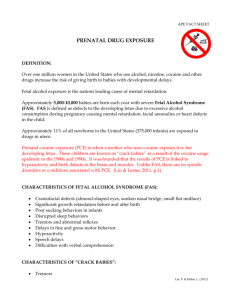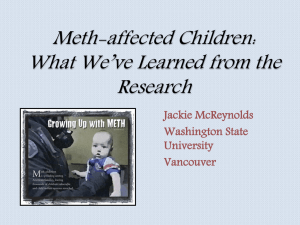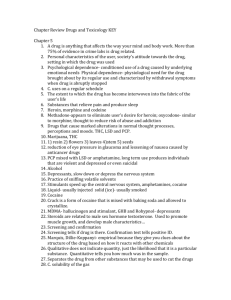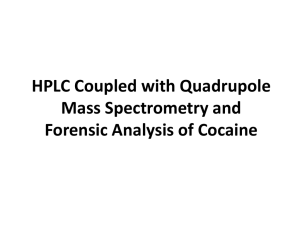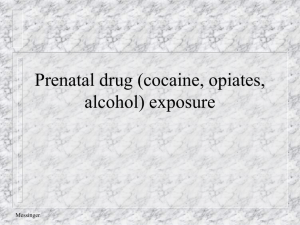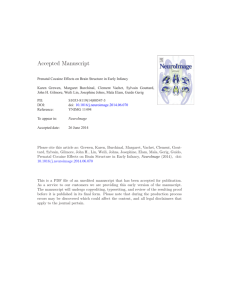– MS Word format - West Virginia Perinatal Partnership
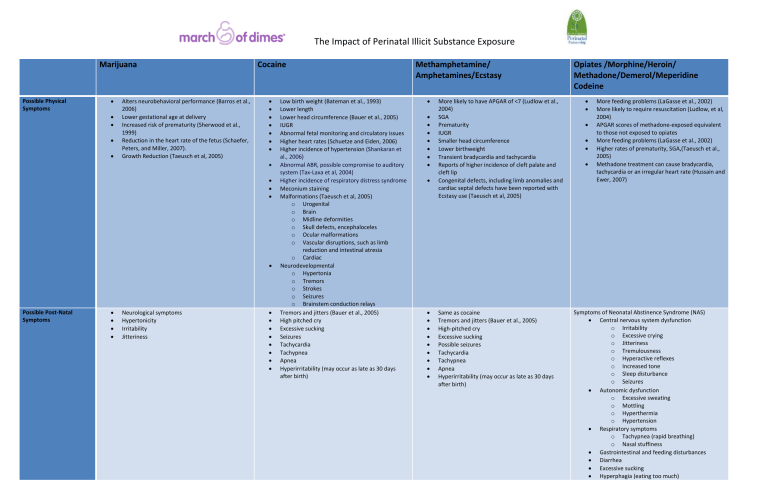
Possible Physical
Symptoms
Possible Post-Natal
Symptoms
The Impact of Perinatal Illicit Substance Exposure
Marijuana
Alters neurobehavioral performance (Barros et al.,
2006)
Lower gestational age at delivery
Increased risk of prematurity (Sherwood et al.,
1999)
Reduction in the heart rate of the fetus (Schaefer,
Peters, and Miller, 2007).
Growth Reduction (Taeusch et al, 2005)
Neurological symptoms
Hypertonicity
Irritability
Jitteriness
Cocaine
Low birth weight (Bateman et al., 1993)
Lower length
Lower head circumference (Bauer et al., 2005)
IUGR
Abnormal fetal monitoring and circulatory issues
Higher heart rates (Schuetze and Eiden, 2006)
Higher incidence of hypertension (Shankaran et al., 2006)
Abnormal ABR, possible compromise to auditory system (Tax-Laxa et al, 2004)
Higher incidence of respiratory distress syndrome
Meconium staining
Malformations (Taeusch et al, 2005) o Urogenital o Brain o Midline deformities o Skull defects, encephaloceles o Ocular malformations o Vascular disruptions, such as limb reduction and intestinal atresia o Cardiac
Neurodevelopmental o Hypertonia o Tremors o Strokes o Seizures o Brainstem conduction relays
Tremors and jitters (Bauer et al., 2005)
High pitched cry
Excessive sucking
Seizures
Tachycardia
Tachypnea
Apnea
Hyperirritability (may occur as late as 30 days after birth)
Methamphetamine/
Amphetamines/Ecstasy
More likely to have APGAR of <7 (Ludlow et al.,
2004)
SGA
Prematurity
IUGR
Smaller head circumference
Lower birthweight
Transient bradycardia and tachycardia
Reports of higher incidence of cleft palate and cleft lip
Congenital defects, including limb anomalies and cardiac septal defects have been reported with
Ecstasy use (Taeusch et al, 2005)
Opiates /Morphine/Heroin/
Methadone/Demerol/Meperidine
Codeine
More feeding problems (LaGasse et al., 2002)
More likely to require resuscitation (Ludlow, et al,
2004)
APGAR scores of methadone-exposed equivalent to those not exposed to opiates
More feeding problems (LaGasse et al., 2002)
Higher rates of prematurity, SGA,(Taeusch et al.,
2005)
Methadone treatment can cause bradycardia, tachycardia or an irregular heart rate (Hussain and
Ewer, 2007)
Same as cocaine
Tremors and jitters (Bauer et al., 2005)
High-pitched cry
Excessive sucking
Possible seizures
Tachycardia
Tachypnea
Apnea
Hyperirritability (may occur as late as 30 days after birth)
Symptoms of Neonatal Abstinence Syndrome (NAS)
Central nervous system dysfunction o Irritability o Excessive crying o Jitteriness o Tremulousness o Hyperactive reflexes o Increased tone o Sleep disturbance o Seizures
Autonomic dysfunction o Excessive sweating o Mottling o Hyperthermia o Hypertension
Respiratory symptoms o Tachypnea (rapid breathing) o Nasal stuffiness
Gastrointestinal and feeding disturbances
Diarrhea
Excessive sucking
Hyperphagia (eating too much)
Marijuana Cocaine Methamphetamine/
Amphetamines/Ecstasy
Opiates /Morphine/Heroin/
Methadone/Demerol/Meperidine
Codeine
Issues at delivery
Late prenatal care (Burns et al., 2006)
More often required NICU admission
Placental abruption (Ananth et al., 2006)
Premature ROM (Addis et al., 2001)
Pre term labor
Less/late prenatal care (Fajemirokin-Odudeyi et al., 2004)
Premature Delivery/prematurity
High risk of maternal death from intracerebral hemorrhage
Stillbirth
High risk of perinatal HIV
Higher risk of syphilis
Higher incidence of stillbirth
Poor prenatal care
Sexually transmitted diseases
Abruptio Placenta
Postpartum hemorrhage
Late prenatal care (Burns et al., 2006)
More often require NICU admission
Antepartum hemorrhage
Increased risk of HIV (if mother an intravenous heroin user)
More likely to require resuscitation (Ludlow et al,
2004)
Higher incidence of placental abruption
Higher incidence of premature delivery, preterm labor
Higher incidence of chorioamnionitis
Higher rates of meconium staining
Higher incidence of SIDS Long Term Impacts First trimester exposure affects child’s depression and anxiety symptoms
Second trimester affects reading comprehension
(Goldschmidt et al., 2004)
Speech and thought impairments (Schaefer,
Peters, and Miller, 2007)
Higher infection rates
Negative behavioral outcomes at 3, 5 and 7 year follow-up (Bada et al., 2007)
Lower IQ scores
Higher risk of SIDS
Hyperactivity
Sleep disturbances
Aggressiveness
Other information In children and adults with pre-existing respiratory problems, worsening of these symptoms may occur with even the slightest exposure to these gases.
(Martyny et al, 2004)
Mothers more likely to be poly drug users Mothers have lower quality of life perceptions
Greater likelihood of substance use in family and social system
Increased risk for ongoing legal difficulties
Increased likelihood of development of a substance abuse disorder (Derauf et al., 2007)
Breastfeeding
Marijuana passes into the breast milk
Half life of up to 57 hours.
Breastfeeding should not occur if marijuana is being used. Exposure to marijuana via breast milk has been associated with delayed motor development (Schaefer, Peters, and Miller, 2007).
Cocaine appears in breast milk within 15 minutes
Half life of less than ½ hour
Clears within 5 hours.
If a mother uses cocaine while breastfeeding, it is recommended that she pump and discard the breast milk for the following 24 hours.
Mothers habitually using cocaine should not breastfeed (Schaefer, Peters, and Miller, 2007)
Amphetamines pass into breast milk.
Half life is unknown.
Women taking amphetamines should not breastfeed (Schaefer, Peters, and Miller, 2007)
All opiates pass into breast milk.
Mothers using heroin should not breastfeed.
Methadone does appear to be well tolerated by the infant when breastfed.
Breastfeeding is strongly recommended, as the infant is not being quickly withdrawn from the methadone. The American Academy of Pediatrics
(2007)
References
Addis, A., Moretti, M. E., Syed, F. A., Einarson, T. R., & Koren, G. (2001). Fetal effects of cocaine: an updated meta-analysis. Reproductive Toxicology, 15, 341-369.
Ananth, C. V., Getahum, D., Peltier, M. R., & Smulian, J. C. (2006). Placental Abruption in Term and Preterm Gestations: Evidence for Heterogeneity in Clinical Pathways. Obstetrics & Gynecology, 107(4), 785-792.
Bada, H. S., Das, A., Bauer, C. R., Shankaran, S., Lester, B., LaGasse, L., et al. (2007). Impact of prenatal cocaine exposure on child behavior problems through school age. Pediatrics, 119(2), e348-359.
Barros, M. C. M., Guinsburg R, Peres C A, Mitsuhiro S, Chalem, E., & Laranjeira, R. (2006). Exposure to marijuana during pregnancy alters neurobehavior in the early neonatal period. The Journal of Pediatrics, 149(6), 781-787.
Bateman, D. A., Ng, S. K. C., Hansen, C. A., & Heagarty, M. C. (1993). The Effects of Intrauterine Cocaine Exposure in Newborns. American Journal of Public Health, 83(2), 190-193.
Bauer, C. R., Langer, J. C., Shankaran, S., Bada, H. S., Lester, B., Wright, L. L., et al. (2005). Acute Neonatal Effects of Cocaine Exposure During Pregnancy. Archives of Pediatrics and Adolescent Medicine, 159(9), 824-834.
Burns, L., Mattick, R. P., & Cooke, M. (2006). The use of record linkage to examine illicit drug use in pregnancy. Addiction, 101(6), 873-882.
Derauf, C., LaGasse, L. L., Smith, L. M., Grant, P., Shah, R., Arria, A., et al. (2007). Demographic and Psychosocial Characteristics of Mothers Using Methamphetamine During Pregnancy: Preliminary Results of the Infant Development, Environment, and Lifestyle Study (IDEAL). The American Journal of Drug and Alcohol Abuse, 33(2), 281 - 289.
Fajemirokun-Odudeyi, O., & Lindow, S. W. (2004). Obstetric implications of cocaine use in pregnancy: a literature review. European Journal of Obstetrics & Gynecology and Reproductive Biology, 112(1), 2-8.
Goldschmidt, L., Richardson, G. A., Cornelius, M. D., & Day, N. L. (2004). Prenatal marijuana and alcohol exposure and academic achievement at age 10. Neurotoxicology and Teratology, 26(4), 521-532.
Hussain, T., & Ewer, A. K. (2007). Maternal methadone may cause arrhythmias in neonates. Acta Paediatrica, 96(5), 768-769.
LaGasse, L. L., Messinger, D., Lester, B. M., Seifer, R., Tronick, E. Z., Bauer, C. R., et al. (2003). Prenatal drug exposure and maternal and infant feeding behaviour. Archives of Disease in Childhood - Fetal and Neonatal Edition, 88(5), F391-399.
Ludlow, J. P., Evans, S. F., & Hulse, G. (2004). Obstetric and perinatal outcomes in pregnancies associated with illicit substance abuse. The Australian and New Zealand Journal of Obstetrics and Gynaecology, 44(4), 302-306.
Martyny, J. W., Arbuckle, S. L., McCammon, C. S., Esswein, E. J., & Erb, N. (2004). Chemical exposures associated with clandestine methamphetamine laboratories. Scientific Report 2004.
Schaefer, C., Peters, P., & Miller, R. K. (Eds.). (2007). Drugs During Pregnancy and Lactation: Treatment options and risk assessment (Second ed.). London: Academic Press.
Schuetze, P., & Eiden, R. D. (2006). The Association Between Maternal Cocaine Use During Pregnancy and Physiological Regulation in 4- to 8-Week-Old Infants: An Examination of Possible Mediators and Moderators. Journal of Pediatric Psychology, 31(1), 15-26.
Shankaran, S., Das, A., Bauer, C. R., Bada, H., Lester, B., Wright, L., et al. (2006). Fetal Origin of Childhood Disease: Intrauterine Growth Restriction in Term Infants and Risk for Hypertension at 6 Years of Age. Archives of Pediatric and Adolescent Medicine, 160(9), 977-981.
Sherwood, R. A., Keating, J., Kavvadia, V., Greenough, A., & Peters, T. J. (1999). Substance misuse in early pregnancy and relationship to fetal outcome. European Journal of Pediatrics, 158(6), 488 - 492.
Taeusch, H. W., Ballard, R. A., & Gleason, C. A. (Eds.). (2005). Avery's Diseases of the Newborn (Eighth ed.). Philadelphia: Elsevier Saunders.
Tan-Laxa, M. A., Sison-Switala, C., Rintelman, W., & Ostrea Jr., E. M. (2004). Abnormal Auditory Brainstem Response Among Infants With Prenatal Cocaine Exposure. Pediatrics, 113(2), 357-360.
Funded by a Community Grant from the March of Dimes.
Also Sponsored in part by The West Virginia Perinatal Partnership A project of the West Virginia Healthy Kids and Families Coalition and West Virginia Community Voices Funded by the Claude Worthington Benedum Foundation
